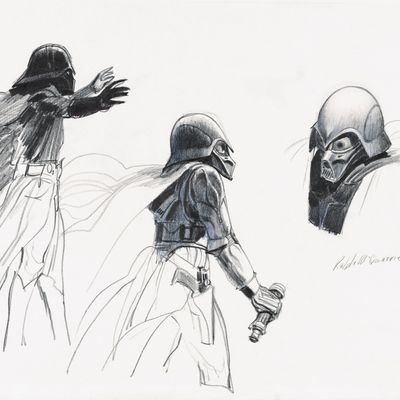
By this point, the imagery of the Star Wars franchise has been carved into the walls of popular culture. Countless millions can picture the costumes of Darth Vader and Han Solo, the skylines of Cloud City and the Forest Moon of Endor, the metallic outlines of R2-D2 and C-3PO. But back when those icons existed only in the mind of George Lucas, he needed help turning his imagined universe into concrete images. For that he turned to a technical artist named Ralph McQuarrie.
Throughout the creation of the original Star Wars trilogy, McQuarrie painted an array of character and world designs, as well as mattes and advertisements. He wasn’t particularly well-known when he died, in 2012, though if David Mandel has his way, that’ll change. Mandel is a longtime television writer, director, and producer, perhaps best known for his work on Seinfeld (he wrote “The Bizarro Jerry,” among other episodes) and his current status as Emmy-winning showrunner for Veep. Mandel’s also a nerd of epic proportions, holding a massive collection of toys and other geek memorabilia in an apartment he keeps solely for storing and displaying his bounty. He is, as you might guess, a big Star Wars fan.
Along with Brandon Alinger and Wade Lageose, Mandel has edited a massive, two-volume collection of McQuarrie’s Star Wars art. The exhaustive set provides a thought-provoking look at the way a single person can build public dreams. It’s especially fascinating to see prototype versions of things like C-3PO’s body (which initially resembled that of the robot Maria in Fritz Lang’s Metropolis) and Vader’s helmet (which made him look like a Kurosawa samurai). We caught up with Mandel to talk about the experience of assembling the epic collection.
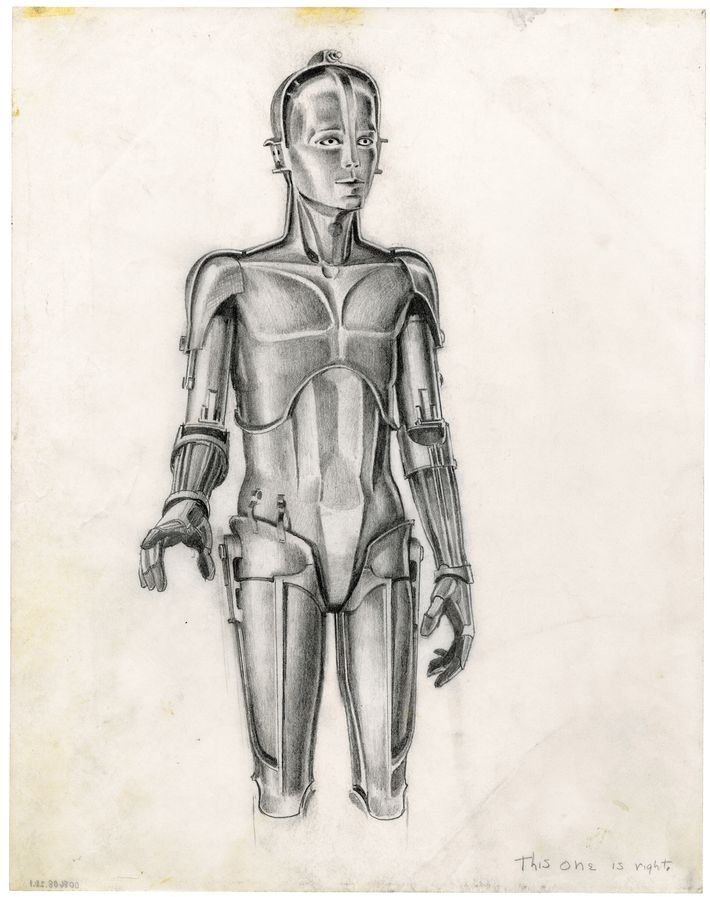
This set is a real labor of love for McQuarrie’s work. When did you first encounter his art?
When I was a kid, I had these portfolios. They sold one for each of the three movies, and they came in this cardboard envelope with poster-y pictures of some of Ralph’s paintings. But even as a kid, I wasn’t just collecting. I was obsessive about trying to keep it all really perfect. I didn’t want anything to happen to them, and of course, they were constantly getting bent and corners dinged and whatnot. It sort of made me crazy. I was a big reader of [sci-fi magazines] like Starlog and things like that. Those were the places in those pre-internet days of 1977 where you went to read about Star Wars. It wasn’t particularly mainstream.
Oh, come on. Star Wars was a massive hit!
In terms of regular coverage, obviously the newspapers were like, “Star Wars this and Star Wars that.” But for stories about the-making-of or the-secrets-of, that’s where you dug deep. The Rolling Stone article with the cast on the cover didn’t mention a lot about Ralph McQaurrie, but Starlog did and Mediascene did. I remember them previewing Ralph designs, which was really cool. It’s out of that world that I started learning the names of some of the Industrial Light & Magic people and also Ralph McQaurrie. I was blown away by the what if aspects of the images. There was a Stormtrooper holding a lightsaber in one. What does that mean? And why is there a guy wearing a breathing apparatus fighting Darth Vader? Who’s he?
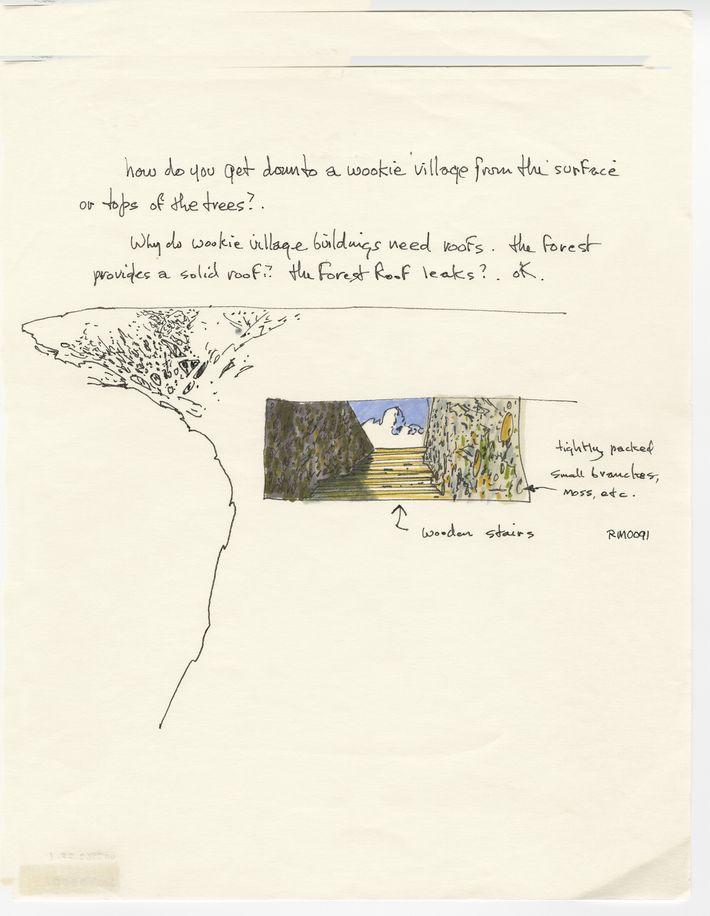
Did you know any answers to those questions at the time?
No. As we dug through old Ralph interviews for the books, some of the images were based on early versions of scripts. But for others, there is no real answer other than Ralph thought it would be interesting.
When did you start collecting McQuarrie’s work?
When I moved out to L.A. to work on Seinfeld, around 1995, I got a bit more serious about my collecting. That was when I started exploring Star Wars movie props, art, storyboards, things like that. On my mind was: Is there such a thing as a McQuarrie original? Many years ago, Ralph himself sold some early sketches. I bought a bit of that stuff and was hooked. I was beyond hooked. I just could not stop. Unfortunately, most of it was at the Lucasfilm archives, so it’s not a healthy obsession.
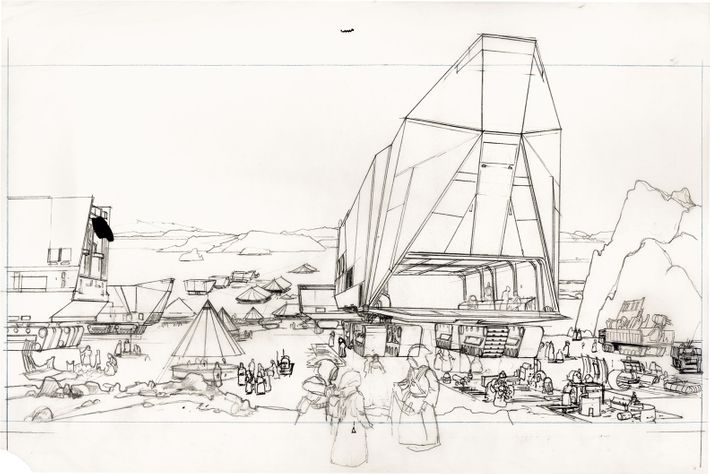
Has most of it survived? Or was stuff thrown away?
One of the more interesting things about Ralph is that a lot of times in his sketching, he worked so small. You can find a piece of paper with tiny thumbnail drawings of either the same piece, different variations of it, or even multiple pieces on the same page. So there’s no way of knowing specifically, Was there another one that somehow didn’t make it?
But the Lucasfilm archives held onto an amazing amount of stuff. I’m sure things got thrown out, I’m sure there are things missing, but we did our damnedest to really get everything Lucas had and then also scour collections that we knew about that might have a couple of pieces here and there.
The book McQuarrie did with Kevin J. Anderson, The Illustrated Star Wars Universe, was a bible to me in grade school. It was such a fascinating idea: to take McQuarrie’s more off-kilter concept paintings, many of them unused for the movies, and have Anderson write in-universe text segments to accompany them. A bitter Imperial scout writing about Endor’s moon, a city councilman writing a tourism pamphlet about Bespin, and so on. It made the Star Wars universe feel so limitless.
Yeah, we got to talk to Kevin a whole bunch. He talked about it as a really special relationship, working with Ralph. I really felt like that showed. Forgetting the sci-fi, you could just tell that these two guys were having fun with the project, if that makes any sense.
Of course it makes sense! Did you ever try to meet McQuarrie?
I didn’t. I’m really bad about that kind of stuff. I’ve heard too many stories about people meeting their heroes and being horribly disappointed, so I’ve avoided it a little bit and then I regret it. I do regret never pushing to meet Ralph, just to shake his hand, just to say hello.

A common criticism of the Star Wars franchise is that it’s purely commercial. How do you convince people that stuff like McQuarrie’s work is art?
You’d have to be blind to think it wasn’t art. Am I ever really going to convince someone of that? I don’t know. But to ignore the craftsmanship that went into the movie because of the money it made seems naïve. People take for granted that so much of that was just brand-new. The very notion that George or Ralph had of this sort of “used space,” these worlds that were worlds were somewhat familiar but yet very different and certainly different from the sci-fi that had preceded it. I guess that’s how I’d convince them.
The books put the artwork in chronological order, and it’s so disorienting to see prototype versions of this iconic imagery, especially because George Lucas went on to become so rigidly protective of the look of Star Wars. In this stuff, you see a lot of playing around and brainstorming.
Looking at the book, I think you get a sense of two things: Ralph’s thought process, and also George’s thought process.
How so?
As George was changing the script for A New Hope, you can see where George would point Ralph in different directions. We have interviews where Ralph talks about how they were going one way and George said, “Try this.” You start to see the effects of some of the other artists like, for example, Joe Johnston, who designed a lot of the ships. Everybody was working on ship design, but maybe Joe was the one who cracked a specific design and then Ralph adopts that design. You get a real feel for what was going on behind the scenes.
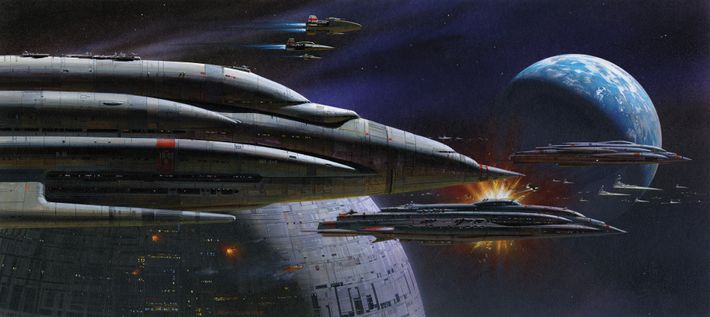
When you were going through the pieces, what surprised you most?
The early Star Wars posters were just photographs of the characters with Darth Vader, but on a starry background. Ralph did the starry background. I was fascinated by what a jack-of-all-trades he was. This was a guy that was not only doing designing but also working on costuming, movie poster ideas, crew T-shirts, and even marketing stuff and Christmas cards. I was taken by how he ran the entire gamut of the production. Also, seeing the developments of R2-D2 and C-3PO, who are so central to the entire saga. Watching C-3PO go from this Metropolis-like robot and slowly become the C-3PO we knew and R2 going from something like a ball — almost like what BB-8 looks like — into the R2 we know.
Is there a piece that moves you more than the others?
Oh, God. It’s one of those answers that changes every five minutes. At the moment, I’m particularly struck by the shot of the Y-wing making its descent into attacking the early version of the Death Star when it was more of a solid metallic ball with rivets. In everybody’s mind at the time, the Y-wings were the more important ship. You’re not seeing X-wings. But what I’m really taken by is, if you look at the the way Ralph draws that Y-wing, there’s so much thought into how this ship might work: where the engines are and how they look and the pilot and his area. There’s just something about that that’s just so different then a flying saucer in your average, terrible sci-fi movie. It was that Boeing training coming through where you could just see that Ralph was going to figure out how this thing flew and then work it into the drawing.
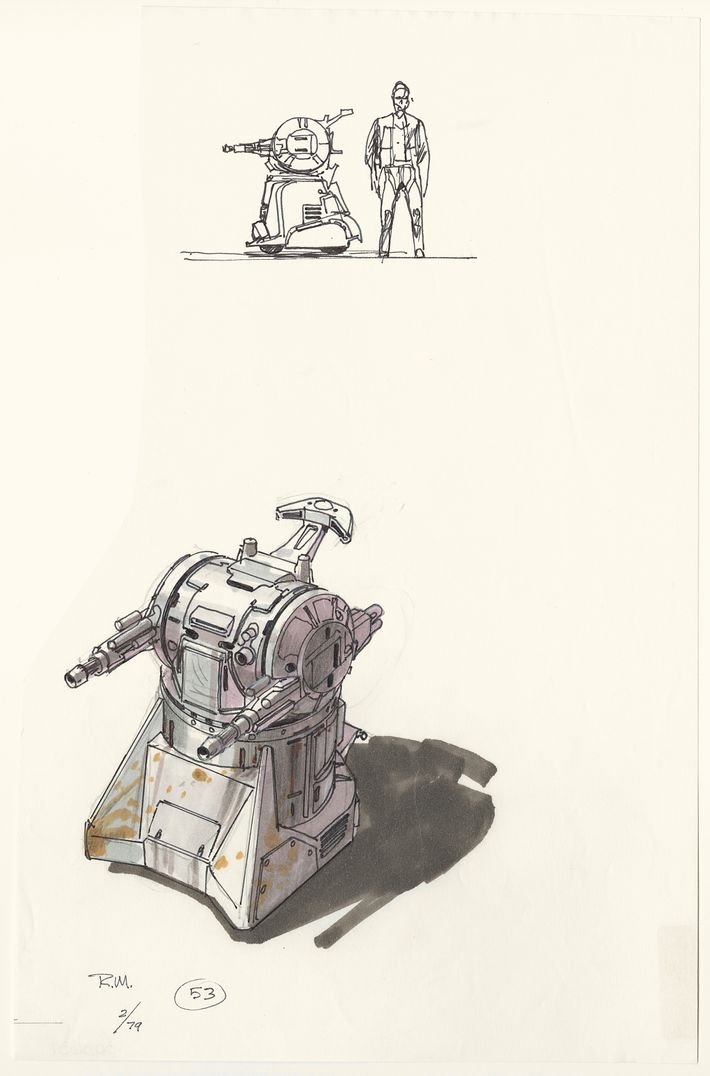
What do you think of the visual direction the Star Wars franchise is taking now, in The Force Awakens and Rogue One?
I mean I loved it. I love the return to something like the original McQuarrie universe. Obviously, they’re taking some of the classic original-trilogy stuff and evolving it forward, but we got to hear, when we were up in the archives, that basically all the different crews are coming through and looking at the old McQuarrie stuff — looking for unused designs and things like that. I feel like he’s much more a spiritual godfather for these new films than in the look of the prequels, where I felt less of a connection.
Did Lucas explicitly say he was moving away from the McQuarrie designs for the prequels?
I have no idea. Not my pay grade.
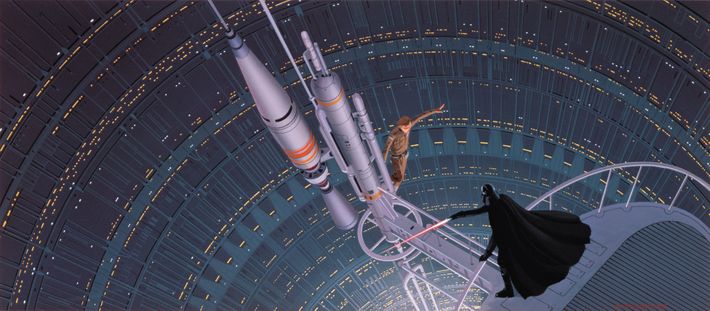
Have you interacted with Lucas at all?
I was lucky enough to meet the man once and we were thrilled that he considered the Ralph book important enough to do the foreword, which was wonderful. And he answered a couple of written questions. But that was about it.
Since they’re handing out Star Wars movies to everybody and there’s going to be one every year until the sun burns out, would you take one up if offered?
If anyone would like to offer me a Star Wars movie, they know where they can reach me. It’ll be a very quick and easy negotiation.

